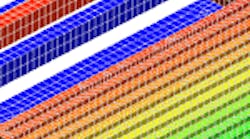CoventorWare 2012 now features a hex-dominant extruded meshing algorithm that can produce 3D simulations such as this one of a MEMS accelerometer with a hex-dominant mesh.
Driven largely by the consumer market, microelectromechanical systems (MEMS) are proliferating like wildfire in electronic systems. Nintendo’s Wii game platform has brought millions of them literally into the hands of consumers, and so has Apple’s iPhone, of which coming iterations will contain multiple MEMS devices.
But if you haven’t designed a MEMS device, you’ll find they’re quite complex, even for a simple MEMS-based actuator. MEMS devices typically comprise sets of interleaved combs, one fixed and the other moving to create variable capacitance. A MEMS simulator must be able to accurately simulate electrostatic fringing fields, differential capacitance, thermal sensitivity, and gas-damping effects simultaneously.
Frankly, there aren’t a lot of options in the market if you’re looking for a MEMS design and simulation tool, so it’s a good thing that Coventor continues to improve and support its CoventorWare product. CoventorWare 2012 offers a number of improvements that allow it to take advantage of state-of-the-art computing platforms. It also brings algorithm advancements to the table.
Like its predecessors, CoventorWare 2012 has two main modules called Designer and Analyzer. The former creates the 3D geometry and builds 3D models. The latter simulates, visualizes, and analyzes performance.
“Our 3D geometry is constrained by the fabrication process,” says Stephen Breit, vice president of engineering at Coventor. Users enter a description of the fabrication process they’ll use for their chip and can then use the same layout for simulation that will ultimately go to the fab.
MEMS devices are modeled using mesh generation. Once the mesh is created, CoventorWare includes a suite of field solvers that use a hybrid of finite-element method (FEM) and boundary-element method (BEM) approaches to modeling.
For example, when modeling an electrostatic MEMS RF switch, the BEM solver uses a surface mesh to solve for the electrostatic force due to bias voltage. The FEM solver uses a volume mesh to solve for solid mechanics displacement. The two calculations are repeated until they converge on a “pull-in” result, or the voltage bias that is necessary for the electromechanical force to overwhelm the electrostatic force.
The hybrid FEM/BEM approach, says Breit, relieves the tool of the task of having to create a mesh that represents the air around the moving part of the MEMS device. “We can solve a full 3D electrostatic problem without meshing the air,” says Breit.
Other approaches to MEMS modeling get around this by creating a simple mesh for the air in the gap between the moving and static parts of the device, but ignore the fringing electrostatic fields around the edges. “For a lot of MEMS designs, these fields are very important for the overall simulation,” says Breit.
Among the highlights of the 2012 release of CoventorWare is full 64-bit support for more accurate solving of very large meshes. This feature gets around the memory limitations of previous releases. Also new is a hex-dominant extruded meshing algorithm that is more efficient for typical MEMS devices (see the figure).
“We worked to ensure that we could use hexagonal elements with six sides and eight nodes,” says Breit. As a result, meshes now can include both quadrilateral and triangular elements, which make for a much more efficient mesh that may have fewer elements for more efficient solving.
A new user interface (UI), dubbed the CoventorWare Console, unifies a lot of functionality in a UI that coexists with the company’s classic UI for easy migration. Finally, a Python scripting capability automatically generates scripts for MEMS analysis, saving a lot of time and effort spent clicking through windows in the interface to get analysis tasks set up.
The CoventorWare 2012 software is available now.
Coventor Inc.
www.coventor.com/products/coventorware/
